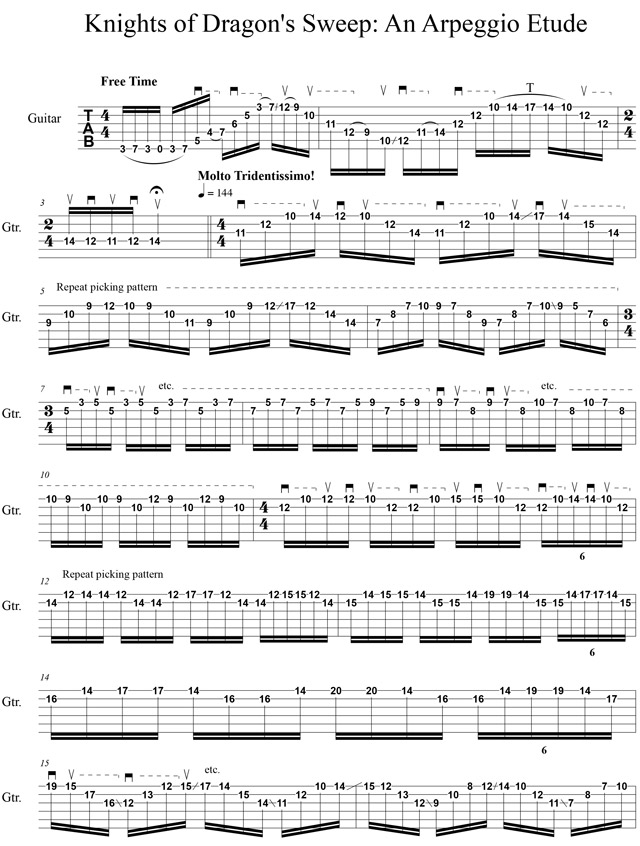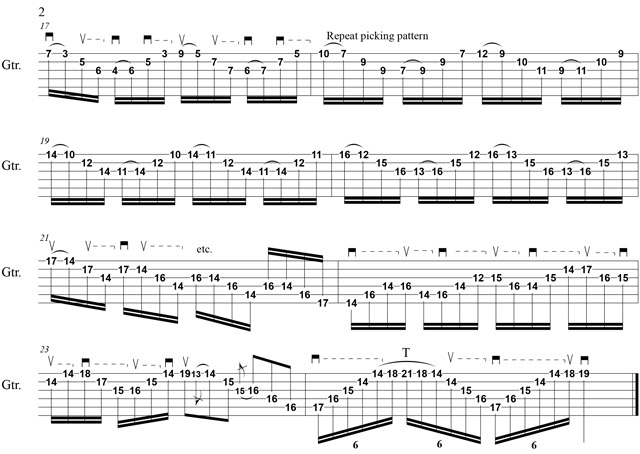A Clean Sweep: Running the Arpeggio Gauntlet
This lesson can provide you with a few patterns and ideas you can incorporate into your own solos and riffs.
“Close your eyes and continue to relax. Envision yourself in a room with neutral beige walls, faded Iron Maiden posters, your favorite ax and a practice amp. The click of the metronome both soothes you and brings your musical mind into sharper focus. The rhythmic clicking of the pick on the strings takes you further and further away. You are feeling very sweepy...”
To conclude our discussion on sweep picking, I’ve constructed "Knights of Dragon’s Sweep," an etude utilizing all of the previous exercises and topics.
If you’ve been keeping up and practicing these different ideas, you should be able to rip through this without too much difficulty.
Here are a few points for consideration: The free time passage at the beginning features the “modal arpeggio” approach from Arcane #5. Even though it uses notes exclusively from the B natural minor scale, it retains a cool and ambiguous sound that covers a lot of the fretboard fairly quickly and temporarily stuns your opponent in the heat of battle.
The abrupt change of picking pattern from measure 6 into 7 can be tricky. Be sure to practice this transition slowly for clarity and make sure no notes are omitted. A similar passage occurs from measure 14 into 15, requiring a swift and accurate shift from the B to the high E string. This etude for the most part is in the key of B (Baron) minor, the fourth saddest of all keys. The passage from m. 15 through m. 21 briefly modulates to E minor (10th saddest) before cycling through a variety of 7th chords. Figuring out which 7th chord arpeggios are in each measure will help you improve your status from peasant to squire.
Measures 21-24 are the most technically challenging and bring Dragon’s Sweep to a dramatic conclusion. A descending sequence through the F# minor pentatonic scale gives way to a knuckle-knotted, chromatically inflected F# dominant 7th arpeggio arranged in groups of five. The fast sweep at the end could most easily be thought of as an F# major with a D in the bass, or a Dmaj7#5 if you want to get fancy.
The picking notated in the music is the exact picking patterns I use, and the same picking ideas that have been covered in the previous lessons. If you’re feeling adventurous, you can experiment with other patterns, but I would encourage you to try the notated picking first. Prove your mettle by playing this etude in its entirety; hopefully there are a few patterns and ideas you can incorporate into your own solos and riffs. Brandish the steel until next time.
All the latest guitar news, interviews, lessons, reviews, deals and more, direct to your inbox!


Baron Taurean Helleshaar is a roaming sell sword and scholar of the forbidden “Music of the Arcane." He has formed an allegiance with the Lords of the Tridentwhile remaining in exile from his home in the Northern Kingdom. His mortal alter ego, Brian Koenig, is lead guitarist for the band Lords of the Trident and teaches music privately in Madison, Wisconsin. He was a founding member of Luna Mortis (Century Media) and has toured the U.S. and Canada. He holds a master's of music in composition from the University of North Carolina at Greensboro and a bachelor's of music in music theory and history from the University of Wisconsin Whitewater.
